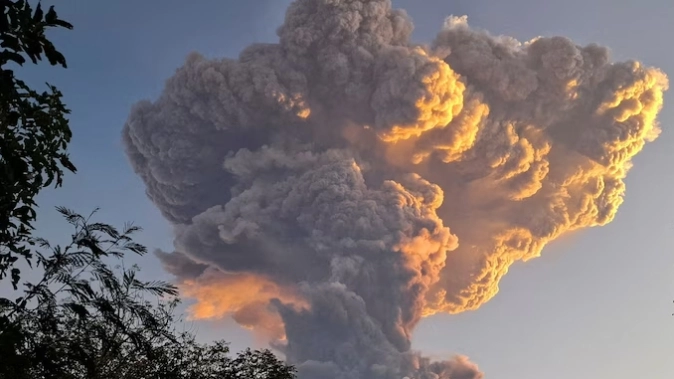 The recent eruption of Mount Lewotobi Laki in Indonesia has drawn global attention with its massive ash plume rising as high as 11 kilometres into the atmosphere. The ash was visible from cities over 150 kilometres away, significantly impacting air travel in the region. More than 37 international and domestic flights to and from Bali’s I Gusti Ngurah Rai International Airport were cancelled. Flights by Air India, Singapore Airlines, Jetstar, Air New Zealand, Juneyao Airlines, and Virgin Australia were among those affected. The Fransiskus Xaverius Seda Airport in Maumere has also been shut indefinitely due to ashfall risks and is expected to remain closed until at least Thursday.
The recent eruption of Mount Lewotobi Laki in Indonesia has drawn global attention with its massive ash plume rising as high as 11 kilometres into the atmosphere. The ash was visible from cities over 150 kilometres away, significantly impacting air travel in the region. More than 37 international and domestic flights to and from Bali’s I Gusti Ngurah Rai International Airport were cancelled. Flights by Air India, Singapore Airlines, Jetstar, Air New Zealand, Juneyao Airlines, and Virgin Australia were among those affected. The Fransiskus Xaverius Seda Airport in Maumere has also been shut indefinitely due to ashfall risks and is expected to remain closed until at least Thursday.
Authorities are particularly concerned as this eruption comes during the monsoon season, which could trigger lahar floods—dangerous volcanic mudflows that occur when heavy rain mixes with volcanic ash.
Mount Lewotobi Laki’s eruption is part of a pattern of increased volcanic activity across Indonesia in June. Volcanic activity was recorded at Mount Ibu on Halmahera Island between June 4 and 10, Dukono on June 5, Mount Raung in East Java on June 14, and Mount Lewotolo in the Lesser Sunda Islands on June 17. These consecutive eruptions have led many to wonder if this frequency is normal or signals an underlying abnormality.
The Centre for Volcanology and Geological Hazard Mitigation (PVMBG), which monitors Indonesia’s volcanoes, had already issued a Level IV alert for Mount Lewotobi Laki, the highest level for volcanic activity. While frequent eruptions may seem alarming, experts assert that this pattern is not unusual for a region situated along the Pacific Ring of Fire, known for its high seismic and volcanic activity.
Dr OP Mishra, Director of the National Centre of Seismology, explained, “Subduction plates in the Ring of Fire region, in which Indonesia also falls, melt due to temperature and pressure. Magma chambers are already present in the area. Due to the propulsive force, the magma erupts due to an earthquake.” He added that this chain of events is part of a regular geological cycle.
Supporting this, Dr Naresh Rana, Professor of Geology at the University of Delhi, said, “There are no anthropogenic causes like climate change in volcanic eruptions or earthquakes. These are independent activities and take many years, sometimes even centuries, to develop. Hence, claims that such back-to-back volcanic activities are happening for some immediate reasons are completely wrong.”
Globally, experts estimate that around 40 to 50 volcanoes are in a state of continuous eruption at any given time, with nearly 20 erupting daily. What appears to be a surge, they argue, is more likely due to greater media coverage, amplified reporting on social media, and advances in monitoring and detection technologies.
Earlier this month, on June 2, a volcanic eruption was recorded in the very active Mount Etna in Italy. Mount Etna, which is located in Sicily, Italy, is Europe’s most active stratovolcano, known for frequent Strombolian eruptions. The most recent eruption was characterised by lava fountains and a pyroclastic flow. The eruption started from the Southeastern crater, which is one of Etna's most active zones. It also resulted in a collapse of a side, possibly due to magma mixing with snow, and the flow travelled approximately 2 km. A dense cloud, low, which went up to almost 6 km in height, was also visible. Mount Etna’s volcanism is driven by its location above the convergent plate boundary where the African Plate subducts beneath the Eurasian Plate. Etna is quite active of late as it witnessed 14 volcanic eruptions in the last 100 days. This activity is due to Etna’s shallow magma chambers, which lie 1–5 km deep and are regularly recharged.
This geological process explains the activity at Mount Lewotobi Laki, which lies on the Sunda Plate’s subduction boundary.
While volcanic eruptions do emit gases such as carbon dioxide and sulphur dioxide - both greenhouse gases - their overall contribution to global warming is minimal. Scientific studies suggest that volcanic emissions account for less than 1% of total greenhouse gases compared to human activities. Localised warming can occur due to lava flows and ashfall, but large eruptions often lead to short-term global cooling rather than warming. This cooling effect, typically 0.1–0.5 degrees Celsius and lasting one to three years, is caused by sulphate aerosols reflecting sunlight away from the Earth.
In conclusion, the recent surge in volcanic activity in Indonesia is part of the region’s natural geological cycle. Experts maintain that it is not a result of global warming or any sudden environmental change, but rather a routine occurrence in one of the world’s most geologically active zones.